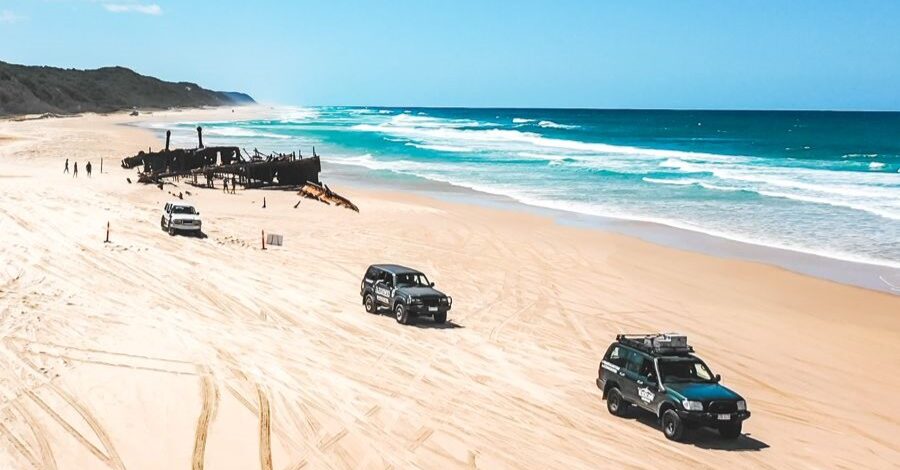05Feb

Fraser Island is a 4WD enthusiast’s dream destination. With its sandy beaches, inland tracks, and stunning landscapes, it’s the perfect place to put your off-road skills to the test. To help you navigate the island safely and enjoyably, here are some essential tips:
- Prepare Your Vehicle
- Engage 4WD Mode: Make sure your vehicle is in 4WD mode before hitting the sand. Reduce tire pressure to around 16-20 PSI for better traction. Carry a tire gauge and portable air compressor to adjust pressure as needed.
- Check Clearance: Ensure your 4WD has enough ground clearance for sandy tracks and water crossings.
- Pack Recovery Gear: Bring essentials like a shovel, recovery tracks, snatch straps, shackles and Check that your vehicle has rated recovery points.
- Know the Tides
- Plan Your Trip Around Low Tide: The recommended times to drive on the beaches are two hours either side of low tide when the sand is firmer and safer. Avoid high tide as the sand along the top of the beach can be soft and challenging and sections of the beach can be cut off due to the tides.
- Check Tidal Charts: Always consult a tidal chart before heading out.
- Drive Smart on Sand
- Keep Momentum: Maintain a steady pace, as stopping abruptly can cause your vehicle to bog down.
- Avoid Sudden Turns: Turn gently to prevent wheels from digging into the sand.
- Stay in Existing Tracks: Follow established tracks where possible to minimize environmental impact.
- Crossing Inland Tracks
- Drop Your Speed: Many inland tracks are narrow, bumpy, and soft. Drive slowly and keep an eye out for oncoming vehicles as some of the tracks are two ways with not much room to pass.
- Engage Low Range: For steep inclines, declines, or deep sand, use low-range gears for better control.
- Watch for Wildlife: Fraser Island is home to dingoes and other wildlife, so drive carefully and respect their habitat.
- Creek Crossings
- Be Cautious: Creeks like Eli Creek can flow quickly. Check the depth before crossing and drive through slowly to avoid water damage to your vehicle.
- Freshwater Warning: Avoid stopping in flowing water as this can wash the sand from under the vehicle wheels and you may become bogged and damage your 4WD.
- Beach Safety
- Watch for Hazards: Keep an eye out for washouts, exposed rocks, and soft patches of sand.
- Stick to Speed Limits: Beaches have speed limits (often 80 km/h in open areas and 30 km/h and 40 km/h near pedestrian zones). Adhere to these limits for safety.
- Plan Your Route
- Use Maps or GPS: Plan your route and familiarize yourself with key points like camping zones, walking tracks, and fuel stations.
- Carry Fuel and Water: Fuel stations are limited on the island, so fill up whenever possible. Bring extra water for your trip.
- Be Dingo Aware
- Secure Food and Belongings: Keep all food and rubbish stored securely to avoid attracting dingoes.
- Follow Dingo Safety Rules: Never feed dingoes, and always stay within fenced camping areas if available.
- Respect the Environment
- Leave No Trace: There are waste disposal sites with industrial bins located at Eurong, Happy Valley and Orchid Beach or take all rubbish with you.
- Stick to Designated Tracks: Off-track driving can harm the island’s fragile ecosystem.
- Stay Connected
- Carry Communication Tools: Mobile coverage can be patchy, so consider carrying a UHF radio or satellite phone.
- Emergency Contacts: Familiarize yourself with the local ranger station and emergency procedures.
Fraser Island is a unique and beautiful destination but driving on its sands requires preparation and respect for the environment. By following these tips, you’ll ensure a safe and enjoyable adventure!
Are you ready to hit the tracks? Start planning your 4WD getaway to Fraser Island today!

Leave A Comment